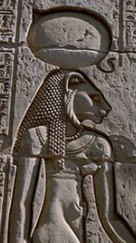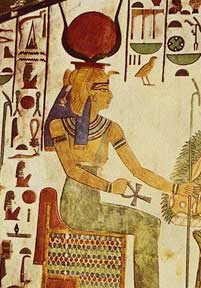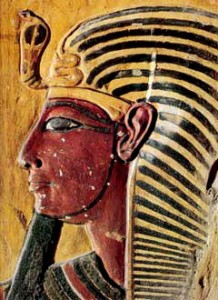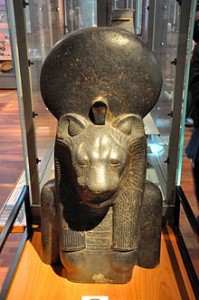Sekhmet, Venus Goddess of Ancient Egypt
 Sekhmet (“The Mighty One”), lioness goddess of ancient Egypt, spread terror with her bloody rampages. Yet she became the protector of kings and a favorite personal goddess of millions of Egyptians.
Sekhmet (“The Mighty One”), lioness goddess of ancient Egypt, spread terror with her bloody rampages. Yet she became the protector of kings and a favorite personal goddess of millions of Egyptians.
Why did Egyptians have a goddess who required such assiduous and even obsessive propitiation? Why did other Egyptian goddesses play roles similar to Sekhmet’s? What explains Sekhmet’s dual nature as destroyer and protector? Why did Egyptians call her the Eye of Ra? Why did she originally appear with an oval disk on her head?
We now have good answers to these questions. But in order to understand them, we need to see why we should think that Sekhmet was Planet Venus. And that requires us to investigate a major case of scientific rejectionism.
The Venus Theory
The biggest controversy in planetary science since Copernicus and Galileo revolves around the question of whether Venus was once a comet.
Psychoanalyst Immanuel Velikovsky’s 1950 book Worlds in Collision1 touched off a bitter debate that went on until his death in 1979 and, in a subdued  but increasingly fruitful way, continues to this day.
but increasingly fruitful way, continues to this day.
Velikovsky interpreted the Greek myth that Athena had sprung fully armed from the head of Zeus to mean that the planet Jupiter had fissioned off Venus as a comet that then entered the inner solar system. Every 52 years Venus approached Earth, Velikovsky argued. Their encounters caused the tsunamis, earthquakes, volcanic eruptions, floods, and droughts of the Bronze Age catastrophes. Finally, after many interactions with Earth and some with Mars, Venus circularized its orbit and gradually lost its cometary tail.
Many scientists found this hard to believe. They pointed out mistakes by Velikovsky. They considered the notion that Venus had emerged from Jupiter contrary to the laws of physics. Many considered Velikovsky a kook and dismissed his theory out of hand.
With the passage of time, however, new evidence and reinterpretation have emerged and now appear in a Revised Venus Theory. Instead of the unpersuasive argument that Venus emerged from Jupiter, another myth that Velikovsky failed to interpret offers a more satisfying explanation.
Zeus turned Metis, after impregnating her, into a fly who then zipped into his mouth. Metis gave birth to Athena inside of him, and then Athena emerged from his head. In effect, a Greek observer had spotted proto-Venus as Jupiter’s immense gravity pulled it from the outer solar system and tidal (gravitational) friction heated it up to incandescence. The Greeks called this Metis. (In contrast to Velikovsky’s contrarian aversion to Newtonian gravity, the Revised Venus Theory assigns gravity a central role.)
Once we reinterpret the origin of Venus this way, then the extensive astronomical, geological, archaeological, historical, calendrical, iconographic, and linguistic evidence that Velikovsky amassed comes to bear. And now telling new evidence from Greece, the Ancient Near East, China, Europe, and Mesoamerica adds to it, as do new interpretations. Thus the Revised Venus Theory shows that Velikovsky was right that Venus repeatedly approached Earth, even if he made other mistakes. His critics threw the baby out with the bathwater.
A Second Theory
Velikovsky had a second theory as well. Herodotus wrote that Egyptian priests had told him that four times since Egypt became a kingdom “the Sun rose contrary to his wont; twice he rose where he now sets, and twice he set where he now rises.” Velikovsky interpreted this to mean that during several approaches of Venus the interaction had caused Earth to turn over. He adduced some evidence for inversion, and physicist Peter Warlow in his book The Reversing Earth2 supplied a mechanism to explain it. Now we have rough estimated dates for the four inversions: 2200, 1628, 1210, and 820 BC,3 and these dates very approximately match Chinese and Egyptian dynastic changes.
We now know that the slow retrograde rotation of Venus was a consequence of tidal locking as it passed Jupiter. Jupiter’s gravitational pull stretched the comet-planet almost to separation, leaving it ovoid, as is depicted in ancient iconography. As it interacted with other planets, Venus gradually became spherical. We also know that Venus first approached Earth some time in the vicinity of 2525 BC (Velikovsky thought it was around 1500 BC).
The Revised Venus Theory puts us in a better position than Velikovsky was to interpret the Bronze Age catastrophes, though he deserves great credit for his two theories. We can also now accurately explain Sekhmet.
Venus Goddesses
While Sekhmet frequently received top billing, at times she had to share the stage with other goddesses. These are best understood as thematic or regional variant representations of Comet-Planet Venus. Hathor, the cow goddess of the Old Kingdom, acquired the role of Venus shortly before 2500 BC because her horns matched the twin tails of Venus. (The planet itself blocked from sunlight the central portion of the tail, hence the name Bull of Heaven in Mesopotamia.) At times Hathor became an avenging destroyer, or the goddess became Hathor-Sekhmet.
thematic or regional variant representations of Comet-Planet Venus. Hathor, the cow goddess of the Old Kingdom, acquired the role of Venus shortly before 2500 BC because her horns matched the twin tails of Venus. (The planet itself blocked from sunlight the central portion of the tail, hence the name Bull of Heaven in Mesopotamia.) At times Hathor became an avenging destroyer, or the goddess became Hathor-Sekhmet.
Bastet, the cat goddess of Lower Egypt, occasionally had a lion head and the soubriquet Devastator. But more often she acted as the benign counterpart of the dangerous Sekhmet: “Sekhmet of yesterday, Bastet of today”, as a hymn from Ptolemaic Edfu put it.4 Like other ancient peoples, the Egyptians distinguished between the Evening Star, which upon occasion would approach and wreak havoc, and the harmless Morning Star. Various temples contained two goddesses representing the aggressive and the peaceful forms of the Eye of Ra (Venus), as with Satet and Anuket at Aswan or Ayet and Nehemtawy at Herakleopolis.5 Sekhmet, for her part, seems to have been primarily the Evening Star. But sometimes she stood for Venus in general and thus had two sides to her nature. Her cult seems to have begun at Memphis during the Fifth Dynasty. Sekhmet’s husband was Ptah.
As consort of Amun, Mut was originally a regional Venus goddess. She came to be the mother of Sekhmet and gradually assimilated with Sekhmet. Hence the Precinct of Mut at Karnak (placed next to the Sun god’s temple just as Venus accompanied the Sun), perhaps previously at the Mortuary Temple of Amenhotep III, contains hundreds of statues of Sekhmet. The idea seems to have been to provide two statues for each day of the year, to worship the Morning Star and the Evening Star.
Tefnut and other regional lion-headed goddesses replicated Sekhmet’s characteristics and were often linked to her. Isis became increasingly important over time and finally assimilated Hathor as a nurturing mother Venus goddess. Isis and Sekhmet were both the mother of Horus.6Seth was a malign male version of Venus, for those who considered Venus a male.
Protector of Ra, Kings, and Cosmic Order
Repeated catastrophic approaches of Venus led the Egyptians to endeavor to channel Sekhmet’s capacity for destruction into the role of a powerful protector. She stood at the prow of the solar bark as it entered the underworld every night so that she could protect the Sun against his enemy Apophis. The ceremonies of the New Year contained sedulous efforts to appease Sekhmet for fear that she might unleash the evil power of the five epagomenal days added to 360 at the end of the old year.
Just as the king derived his power from Ra and emulated him, so Sekhmet protected the king. Sekhmet suckled the king,7 and kings came to proclaim themselves sons of Sekhmet. Through her protection of the king, who was responsible for maintaining the cosmic order, Sekhmet became the protector of the cosmic order itself. Thus at every occasion it was essential to placate Sekhmet. Otherwise, she might run amok, her hot breath spreading fire and pestilence. Meanwhile, the king relied on Sekhmet to smite his enemies, foreign and domestic.
Two myths sprang up around Sekhmet.
In The Distant Goddess myth, Sekhmet wandered off to the Nubian desert, so Ra sent messengers to persuade her to return. When she did, she flew into a rage because Ra had replaced her as his Eye. To placate her, Ra placed Sekhmet/the Eye on his forehead in the form of a serpent or cobra, the uraeus, which was to govern the entire world.8 The serpent or cobra, of course, was a fitting incarnation of a comet-planet that preceded the Sun, while the Eye of Ra presumably referred to the oval shape of the Sun’s companion Venus. In a Babylonian parallel, on the stele of Hammurabi the Sun god Shamash (also god of justice) wears a serpent headdress with an oval head behind Shamash’s neck.
she flew into a rage because Ra had replaced her as his Eye. To placate her, Ra placed Sekhmet/the Eye on his forehead in the form of a serpent or cobra, the uraeus, which was to govern the entire world.8 The serpent or cobra, of course, was a fitting incarnation of a comet-planet that preceded the Sun, while the Eye of Ra presumably referred to the oval shape of the Sun’s companion Venus. In a Babylonian parallel, on the stele of Hammurabi the Sun god Shamash (also god of justice) wears a serpent headdress with an oval head behind Shamash’s neck.
The distancing of Sekhmet could allude to the disappearances of Venus at Superior Conjunction and Inferior Conjunction. It could also refer to the approaches of Venus to Earth.
In a second myth, The Destruction of Men, Ra grew old, and men began to plot against him, withdrawing to the desert. Ra sent his Eye in the form of Hathor who, as a furious lioness, proceeded to slaughter them. Not wanting to exterminate humans, Ra had a beer made that had the color of blood, and he made it inundate the place of massacre. Hathor (Sekhmet) lapped it up and became drunk, so she stopped killing.
This myth alludes to times when the Sun was seen as growing old (as in Aztec myth) and Venus approached especially close to Earth. Four times this led to a catastrophic inversion of Earth and the replacement of the old Sun with a new one. This might explain why the Sun acquired the names Re Horakhty, Amun, and Aten, though this requires further investigation.
Iconography
 Sekhmet traditionally appeared with an orb on her head. This began as a distinctly oval orb between two horns (the twin tails of Venus). Over time, as Venus itself became more spheroid, the orb became circular as well and came to be termed a solar orb. Thus in a confusing and ambiguous way, especially under King Akhenaten, the solar orb came to be considered the Sun itself.
Sekhmet traditionally appeared with an orb on her head. This began as a distinctly oval orb between two horns (the twin tails of Venus). Over time, as Venus itself became more spheroid, the orb became circular as well and came to be termed a solar orb. Thus in a confusing and ambiguous way, especially under King Akhenaten, the solar orb came to be considered the Sun itself.
In her typical frontal view, Sekhmet wore a double wig that reached down to her breasts, representing the twin tails of Comet Venus. Sekhmet’s dress was red, and she was called “mistress of the red linen” and the “Scarlet Lady”. Red was a common color for Comet Venus worldwide because the atmospheric and interplanetary dust stirred up by Venus gave it a reddish hue. The Great Sphinx, an effigy of Venus as a lion and thus in some manner related to Sekhmet, was painted red.
Sometimes Sekhmet’s outfit has a rosette over each breast9, presumably symbolizing the Morning Star and the Evening Star.
A Popular Goddess
Over time Sekhmet became associated with Osiris and the realm of the dead, protecting Osiris in his struggles with Seth.
Sekhmet played a major role in medicine, where she spread pestilence, as evidently occurred during Earth’s catastrophic encounters with Venus. Yet she mainly served as a protector from sickness or protector of the sick. Already during the Old Kingdom, some doctors doubled as priests of Sekhmet who would use magic to ward off diseases. Thus Sekhmet became a favorite goddess to petition for recovery from disease. In turn, this role extended into widely popular devotion to Sekhmet among millions of Egyptians, Nubians, and others. Thousands of Sekhmet statuettes, scarabs, amulets, and other good luck charms have come down to us. People would exchange amulets at New Year celebrations. A humble Egyptian would implore Sekhmet to protect his health, his family, his crops, and so on. This practice continued alongside the temple cult of Sekhmet into Roman times, long after Venus had lost most of its tail in encounters with Earth and Mars, and had circularized its orbit so that it no longer approached Earth.
Conclusion
In recent times, Sekhmet has become a cult figure. But neither her new devotees nor Egyptologists seem aware that Sekhmet was in fact Comet-Planet Venus. Sekhmet’s story is not a flight of fancy but rather a lesson in how a great ancient civilization grappled with an all-too-real and terrifying threat to its existence. The Bronze Age catastrophes that dried up the Nile, caused the plagues of Egypt, drove ravenous mobs to attack granaries, toppled dynasties, and spawned a touching lamentation literature were not figments of the Egyptians’ imaginations.
At the same time, the evidence about Sekhmet constitutes yet more documentation of the correctness of a revised and enhanced version of the Venus theory. Velikovsky made his share of mistakes, but his main contention–that Venus had repeatedly approached Earth and caused the Bronze Age catastrophes–was on target. Scientists’ rejection of Velikovsky and his Venus theory is arguably the world’s leading ongoing case of scientific rejectionism. Every scientist and educated lay person should know about it.
For decades planetary scientists have used peer review in scientific journals to block publication of evidence and arguments supporting Velikovsky’s theory. But this is an interdisciplinary problem. It requires correct interpretation of historical sources as well as a modest amount of basic scientific knowledge. With a little instruction, an intelligent 10-year old can understand it. Thus well-informed non-experts, working together, possess the clout to assure that this fundamentally important episode of humankind’s past and essential phenomenon of planetary science does not remain misconstrued or forgotten forever. We can all contribute by learning more, starting with the Revised Venus Theory and perhaps the most intuitive of the findings it has led to. We can all spread the word until countless millions know this story, and scientists and the media can no longer ignore it and retain credibility.
*****
Kenneth J. Dillon is a historical and scientific researcher. See the biosketch at About Us. The Revised Venus theory figures in the plot of his novel of discovery science Rosemarie (Washington, D.C.: Scientia Press, 2021).

